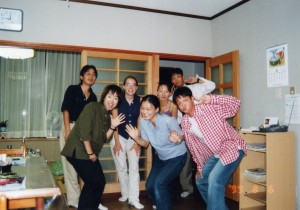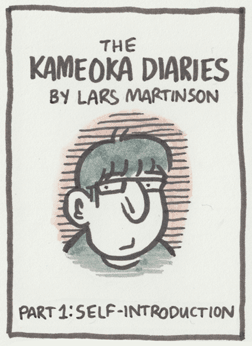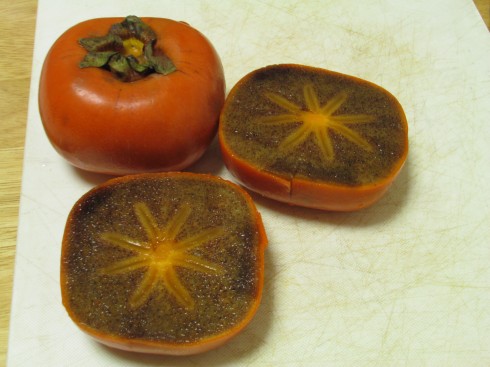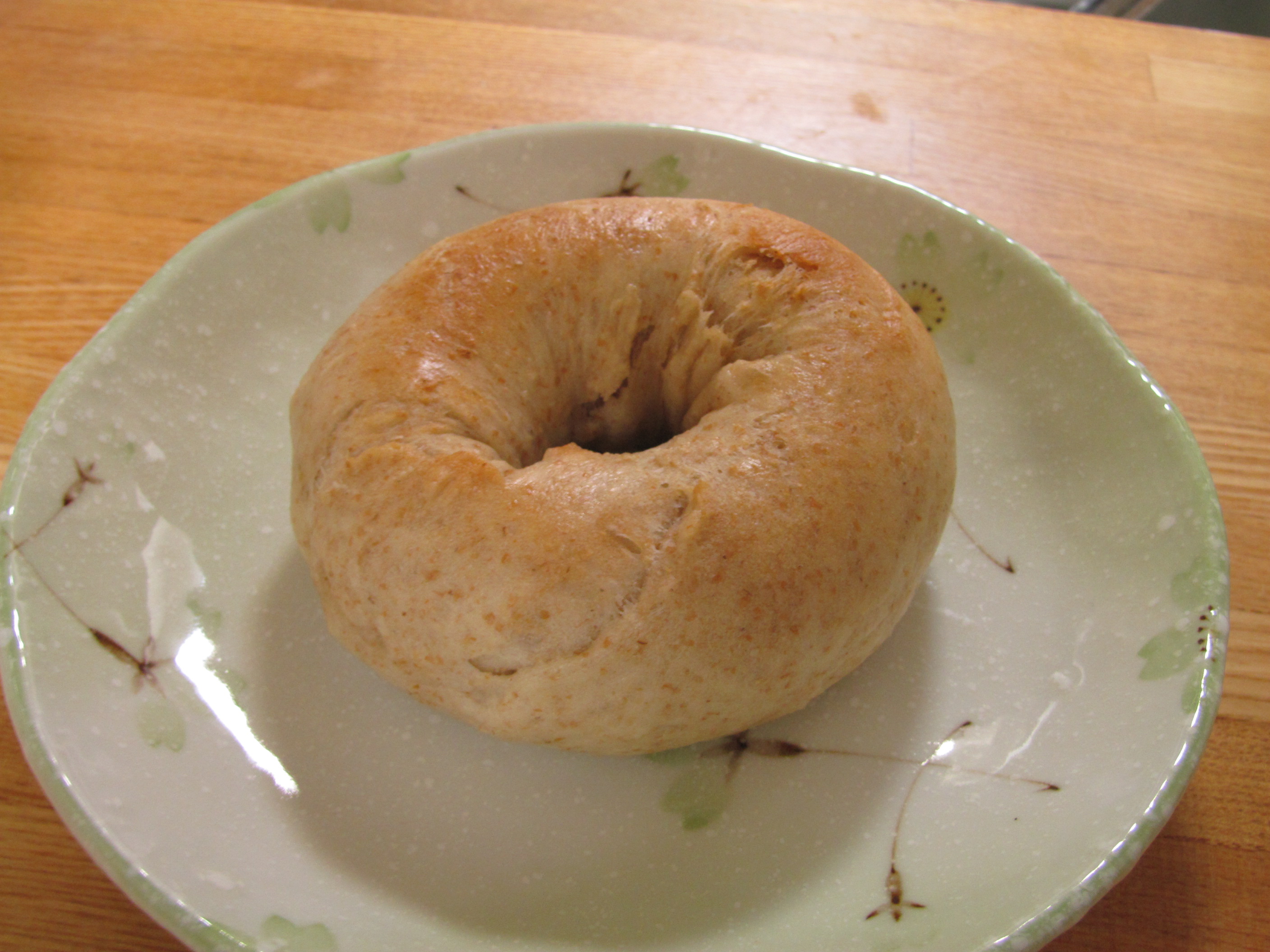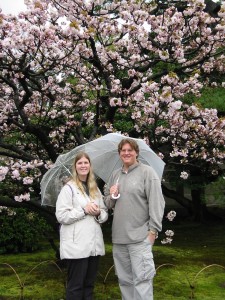The Rice Cooker Chronicles: “Broccoli Lover Learns to BBQ, Part 1” by Clara Solomon
The Rice Cooker Chronicles is a series of essays by JETs and JET alumni on the theme of cooking/eating and being alone in Japan. The brain-child of JETwit founder Steven Horowitz (Aichi-ken, Kariya-shi, 1992-94) (and inspired by the book Alone in the Kitchen with an Eggplant), this series is curated by L.M. Zoller (CIR Ishikawa-ken, Anamizu, 2009-11), the editor of The Ishikawa JET Kitchen: Cooking in Japan Without a Fight. A writer and web administrator for The Art of Japan: Kanazawa and Discover Kanazawa, ze also writes I’ll Make It Myself!, a blog about food culture in Japan.
New submissions always welcome. Just e-mail it to jetwit [at] jetwit.com.
*****
Broccoli Lover Learns to BBQ
Part 1
by Clara Solomon (CIR, Nichinan-cho, Tottori-ken; 1999-2001), the Director of Counseling & Career Development at the Office of Career Services at New York University School of Law. She previously worked for the Japan External Trade Organization, specializing in trade relations between Japan and Latin America. She lives in Queens with her husband and twin daughters.
Many of my experiences in Japan are tied up in the experience of food and cooking. Sure, I have my fill of the standard repertoire of “how many weird things will the American try?” My favorite of those is the night I was out at a new inn in my town, one that specialized in fresh, local food, with a “high end rustic” slant. So, I’m out with some co-workers enjoying a truly delicious meal, when they put a plate of glistening, dark red sashimi before me and say “to-rai, to-rai” (try, try). I wasn’t quite sure what this fish was, it was darker red than any tuna I’d ever seen, so dark it was almost purple, or black. There were thick veins of white fatty meat running through each piece – it almost looked like raw beef, though I could tell from the smell and texture that it was fish. “What is this?” I innocently asked, knowing full well that they wouldn’t tell me until I ate it. This game was a favorite of my colleagues, and they again said “to-rai.” So, I tried it. The minute I popped the full piece in my mouth, the entire table burst out with giggles and choruses of “Greeenpeesu! Greenpeesu!” Yes, Greenpeace. Turns out, I was eating endangered whale, the fishing and eating of which Japan has long been at odds with environmental groups like Greenpeace over (not to mention UN conventions, and the opinion of much of the rest of the world, minus Norway and the Inuit). How was it, you ask? Honestly, not that memorable. For one, it was extremely cold, indicating that it had probably been frozen and shipped to my town from somewhere further south (so much for eating local). For two, I think I would have rather had a piece of fatty tuna, whose rich, buttery flavor far outshone this piece of whale.
I could go on for pages regaling you with stories about the strange things I was given to eat, and the strange situations in which I found myself eating them (wild boar on live TV, anyone?). But, when I think back to the essence of my eating, drinking and cooking in Japan, those are only the warm up acts, the comedy routines that politicians put into the beginning of their stump speeches to play to the base and entice the crowds to stick around for the meat and potatoes (not that I had a lot of meat and potatoes in Japan…). My story of food in Japan is one of cooking and sharing, and gaining not only friends, but also self confidence in the process. Read More
“Tonoharu” author Lars Martinson launches new webcomic – “Kameoka Diaries”
Lars Martinson (Fukuoka-ken 2003-2006), author of the graphic novels Tonoharu: Part Two andTonoharu: Part 1, has just launched a new cartoon series called “Kameoka Diaries“ about his return to teaching English, this time in Kameoka, Kyoto.
Click hereto read the post and the first cartoon.
WIT Life #187: Norwegian Wood
WIT Life is a periodic series written by professional Writer/Interpreter/Translator Stacy Smith (Kumamoto-ken CIR, 2000-03). She starts her day by watching Fujisankei’s newscast in Japanese, and here she shares some of the interesting tidbits and trends together with her own observations.
This week I attended the Japan Society’s member screening of Norwegian Wood, the film version of this Haruki Murakami novel. I haven’t read the book, but the movie was quite moving. It takes place in the late 1960’s with student riots as a backdrop. It is a love story centering on the university student Toru Watanabe, who is torn between his first love from his hometown, Naoko, and a new women he meets at school, Midori. His relationship with Naoko is complicated as their mutual best friend (and Naoko’s boyfriend) committed suicide when they were in high school. They share this bond, but it is also the source of Naoko’s mental instability. Midori is a bit of a brighter character, though her life has been overshadowed by family members’ untimely deaths. The film is quite tender in its exploration of these relationships and the direction Toru’s future will take.
The movie was made in 2010 by the French-Vietnamese director Anh Hung Tran, who was on hand at the screening along with Rinko Kikuchi who plays Naoko (pictured above with Kenichi Matsuyama who plays Toru). They offered some behind the scenes stories, such as how Read More
December edition of “AJET Connect” now online
***************
A really terrific December edition of AJET Connect online magazine is now available for viewing at:
https://s3.amazonaws.com/AJET/AJET+Connect+DEC+2011.pdf
JET alum paper published: “A New Framework for US-Japan Development Cooperation”
Jim Gannon (Ehime-ken, 1992-94), Executive Director of the Japan Center for International Exchange (JCIE/USA), has a new paper published as part of JCIE’s “Enhanced Agenda for US-Japan Partnership” paper series titled:
- “A New Framework for US-Japan Development Cooperation“ (PDF) http://www.jcie.org/researchpdfs/USJapanPapers/Gannon.pdf
Click here for other JCIE papers in the series.
The Rice Cooker Chronicles — “Kaijo!” by Justin Maki
The Rice Cooker Chronicles is a series of essays by JETs and JET alumni on the theme of cooking/eating and being alone in Japan. The brain-child of JETwit founder Steven Horowitz (Aichi-ken, Kariya-shi, 1992-94) (and inspired by the book Alone in the Kitchen with an Eggplant), this series is curated by L.M. Zoller (CIR Ishikawa-ken, Anamizu, 2009-11), the editor of The Ishikawa JET Kitchen: Cooking in Japan Without a Fight. A writer and web administrator for The Art of Japan: Kanazawa and Discover Kanazawa, ze also writes I’ll Make It Myself!, a blog about food culture in Japan.
New submissions always welcome. Just e-mail it to jetwit [at] jetwit.com.
******
Kaijō!
by Justin Maki (ALT Osaka-fu, 2002-06), a writer and editor currently working at the Sports desk of Kyodo News America in New York City. Justin’s short fiction, poetry, and essays have appeared in a handful of small journals. Contact him at makij408@gmail.com.
“When you go to the kitchen to prepare dinner, be born in the kitchen. When you finish there, die. Then be born at the dining table as you eat your dinner and, when you finish eating, die there. Be born in the garden, and sweep with your broom. When you get into bed at night, die there. And when daylight comes, and you awaken in your bed, be born anew.”
WIT LIfe #186: 今年の漢字
WIT Life is a periodic series written by professional Writer/Interpreter/Translator Stacy Smith (Kumamoto-ken CIR, 2000-03). She starts her day by watching Fujisankei’s newscast in Japanese, and here she shares some of the interesting tidbits and trends together with her own observations.
At Kyoto’s Kiyomizu Temple, 今年の漢字 (kotoshi no kanji), or the kanji of the year was just announced to be 絆 (kizuna) or bonds between people. According to the Japanese Kanji Proficiency Society, the rationale behind its selection by the based on ideas from the public was that in a disaster-ridden year that brought a nation closer together, kizuna best reflects the events of 2011. These bonds include those among family members, friends and neighbors, as well as refers to support from abroad. It was chosen with the hope that the world will continue to coalesce to help restore Japan.
As for how this year’s お正月 (oshougatsu) nine months after the disaster will be spent, it seems as if most people are being low-key and staying close to home due to 3-11. Many are still in mourning for the lives that were lost, and this probably will continue until the one-year anniversary next year. People aren’t even sure what to write on their new year’s cards, as the typical 新年おめでとう (shinnen omedetou) or “Happy New Year!” may not be appropriate. Below are some suggestions (in Japanese) for what to write on 年賀状 (nengajou) to those in the disaster area. Read More
I’ll Make It Myself — Spiced Persimmon Cake
L.M. Zoller (CIR Ishikawa-ken, Anamizu, 2009-11) is the editor of The Ishikawa JET Kitchen: Cooking in Japan Without a Fight. A writer and translator for The Art of Japan: Kanazawa and Discover Kanazawa, ze also writes I’ll Make It Myself!, a blog about food culture in Japan.
桃栗三年柿八年 (momo kuri sannnen kaki hachinen): it takes time to reap the fruit of one’s actions
(lit. [It takes] three years for [planted] peach and chestnut trees, eight for persimmons [to bear fruit]) (ことわざ学習室)
In late autumn and early winter (mid-Nov. to New Year), Omicho Market is awash in reds and oranges: strawberries, crabs, mikan, and persimmons. Before I moved to Japan, I had never seen a persimmon, though they seem to be available in California. There are two main varieties available in Japan: non-astringent (amagaki, 甘柿) and astringent (shibugaki, 渋柿). Fuyu (富有), the tomato-shaped variety, are a variety of sweet persimmon; they are dull orange, firm, and ready to eat when they are sold. The human-heart-shaped Hachiya (蜂屋), on the other hand, is very astringent until the skin turns reddish and the insides turn to jelly.*
I tend to eat Fuyu persimmons plain, but I was inspired by The Food Librarian‘s “Fuyu Persimmon Bundt” to try something new.
CLICK HERE to read the full post.
***********************
WIT Life is a periodic series written by professional Writer/Interpreter/Translator Stacy Smith (Kumamoto-ken CIR, 2000-03). She starts her day by watching Fujisankei’s newscast in Japanese, and here she shares some of the interesting tidbits and trends together with her own observations.
Time truly flies, as I can’t believe it has been so long since I’ve been here. At any rate, tadaima!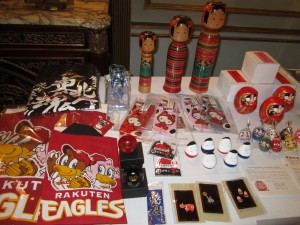
Although almost nine months have passed since the earthquake/tsunami in Fukushima, and I am glad to say that the recovery effort is still on people’s minds. Last night I went to the Artist Showcase and Fundraiser for Japan held at Ambassador Shigeyuki Hiroki’s Residence. The event featured a reception honoring a visiting Fukushima prefectural government delegation to New York, along with artwork (some from JET alumni!) available for silent auction purchase.
Ambassador Hiroki offered his comments, and a representative of the Fukushima prefectural governor read a letter from him on his behalf. On display were Fukushima goods, and guests partook of Fukushima sake as well as Read More
L.M. Zoller (CIR Ishikawa-ken, Anamizu, 2009-11) is the editor of The Ishikawa JET Kitchen: Cooking in Japan Without a Fight. A writer and translator for The Art of Japan: Kanazawa and Discover Kanazawa, ze also writes I’ll Make It Myself!, a blog about food culture in Japan.
Despite my oft-mentioned love of turkey, I had actually never cooked one until this year. In between being a super serious high-school student buried in a stack of books during the holidays and being a super-serious undergrad/grad student visiting from out of state, still buried in a stack of books and often rushing to get back home in time for holiday meals, I somehow seemed to have missed participating in the time-honored ritual of roasting a whole bird. This year marked my third consecutive Thanksgiving missed because I live in Japan, so rather than cry over my twitter feed of satisfied turkey-eaters in the US, I decided that my upgraded oven range was going to good use this year: we would host Thanksgiving, and, moreover, we would cook the turkey.
CLICK HERE to read the full post.
I’ll Make It Myself– ベーガル革命: Whole-Wheat Bagels
L.M. Zoller (CIR Ishikawa-ken, Anamizu, 2009-11) is the editor of The Ishikawa JET Kitchen: Cooking in Japan Without a Fight. A writer and translator for The Art of Japan: Kanazawa and Discover Kanazawa, ze also writes I’ll Make It Myself!, a blog about food culture in Japan.
もちもち (mochimochi): springy (texture)
Back in my language-school days at Midd, a New-Yorker foodie friend got on my case for eating the dining-hall bagels, telling me, “That’s not a bagel. That’s a piece of bread shaped like a bagel.” It’s probably for the best that he doesn’t find out what sort of things pass for “bagels” in Japan–it’s more like “cake shaped like a bagel.” Sometimes you can get passable bagels in the chain bakeries of Kanazawa, and Kaldi Coffee sometimes has imported frozen bagels, but they’re a bit pricey. Either way, it’s not just like popping over to Espresso Royale for a fresh Barry’s Bagel during an intense paper-writing session.
Bagels are one of those foods that seem very intimidating in part because of the multi-step process of making them: using yeast, letting the dough rise, shaping, boiling, and then finally baking; and in part because you really never need to make them in the US when they’re so widely available.
CLICK HERE to read the full post.
Posted by Ashley Thompson (Shizuoka-ken, 2008-2010) of Surviving in Japan: without much Japanese and Lifelines columnist for The Japan Times.
Most homes in Japan aren’t equipped with central heating, so people typically rely on space heaters and similar items. Now, we all know that wearing some extra clothes and warm fleece is a good way to avoid turning the heat all the way up, but most likely you will need (or desperately want) a heater at some point.
And, just to note, I am not an expert on heaters, so if you are curious about how a heater works a certain way, go ahead and google that.
Also, most of the heaters below have timers and auto-turnoff options in addition to running constantly. They also often have automatic shutoff features such as if the heater fell over.
*Keep in mind another way heater might be written is 電気ストーブ (denki stobu).
*The word used for “heating” is 暖房 (だんぼう, danbou).
A guide to heaters in Japan
1. Aircon – エアコン
The air conditioner is commonly known as an aircon in Japan, and most aircons are equipped with a heating function. So, if you have an aircon, you may want to check that out (look for “暖房”). From experience I know it does a pretty good job heating a room, although I found that all the heat rose to the ceiling which was somewhat pointless if you spend most of your time sitting on the floor and don’t have a ceiling fan.
I also found that running the aircon was incredibly expensive. Some are much more energy efficient (look for 省エネ on the outside or description). Aircons are also one of the more expensive options, considering that most will be ¥30,000 – 40,000 and up, depending on the size.
2. Oil heater – オイルヒーター
This heater is the one that looks like a radiator, and some of you may be familiar with already. My family used these when I was a kid, and though they work really well, they are typically energy hogs. Some are better than others though, so it’s best to compare when looking at energy usage. Some of the ones I looked at operate at 1200 watts at the highest level, with an estimated ¥15-20/hour cost to operate (though this varies). Price may range from ¥5,000 – 30,000, though it’s possible to find cheaper options at a recycle shop (this goes for all of the following options as well).
3. Panel heater – パネルヒーター
CLICK HERE to read the rest of the post.
Posted by Ashley Thompson (Shizuoka-ken, 2008-2010) of Surviving in Japan: without much Japanese and Lifelines columnist for The Japan Times.
I wrote Part 1 of this “Giving Birth in Japan” series last week, so if you haven’t read that already, you may want to before reading Part 2 below.
********
As I was being stitched up, I started shivering uncontrollably. Of course, the temperature in the room had been pretty low as I was sweating and hot throughout the labor and delivery. My husband changed the temp while the nurses helped me change out of my sweaty long t-shirt. (Note: this particular clinic, and probably many others, provide hospital gowns that women typically wear throughout their stay. However, the gowns at this clinic were really uncomfortable and stiff-feeling, so I brought my own clothes to wear for the birth and for the stay. We discussed this with one of the midwives at the clinic beforehand so it wasn’t an issue.)
The nurses also had to put these giant pads on me that were sort of like a diaper as all of the blood came out (sorry, graphic I know), which they changed several times right after I had given birth.
After all this, baby was cleaned up and I got to hold her, and also try nursing her. One important thing I should point out is that depending on where you deliver, the midwives or nurses may have different ideas on the best way to breastfeed. We had been warned beforehand that this clinic wasn’t that great with breastfeeding support, and it seemed like almost every nurse/midwife had a different idea about how it should be done. Initially, they only had the baby feed for a few minutes on each side, and then took her away for some tests. One of the nurses explained that the baby should only eat for 5 minutes on each side and then switch, and many of the others nurses also reemphasized this, but some of them didn’t care about the length of time. And everyone had different ideas of how to manually express milk as well, but a pump was frowned upon).
I was still exhausted and a little out of it for that part, but if I went through this process again I probably would have requested to let her feed longer if she was willing to, instead of just pulling her off after less than 10 minutes. I also would have wanted more skin-to-skin time with the baby, since I was fully clothed again (like I mentioned in the previous post, modesty is preferred) and baby was bundled up as well.
I had to go to the bathroom around this time (it had been a while since I last peed), so asked if I could go. The nurse gave me some cleansing wipes, a pad, etc., and walked with me to the bathroom. I have to tell you, I was so weak at this point, and sore, that it was difficult just getting there. As I was going about my business, I became really faint and lightheaded. My head felt heavy and I had to lean over between my knees.
I should make a brief note that I’ve had various instances happen in my life when I’ve become very lightheaded and faint, and I either nearly pass out or actually do. Usually I try to lay down before I pass out completely, but sometimes it’s been hard to avoid.
So I told the nurse I was lightheaded, and she said we should walk back to the room. I tried standing up, but I found it difficult to stay standing and fell over the sink, grabbing the counter. I willed myself to stay conscious enough to walk back so I could lay down.
That didn’t happen. The nurse called another nurse and they both held onto me as I stumbled my way down the hall. I ended up falling to the floor since I completely lost strength and neither of them could hold me up. There I was laying on the floor in the hallway, just outside the LDR room as one of the nurses called for my husband. The last thing I remember before I blacked out was my husband wrapping his arms around me to pull me up. –– CLICK HERE to read the rest of the post.
I’ll Make It Myself! — Travel Checklist: Local Foods in Hida-Takayama, Part 2
L.M. Zoller (CIR Ishikawa-ken, Anamizu, 2009-11) is the editor of The Ishikawa JET Kitchen: Cooking in Japan Without a Fight. A writer and translator for The Art of Japan: Kanazawa and Discover Kanazawa, ze also writes I’ll Make It Myself!, a blog about food culture in Japan.
Travel Checklist: Local Foods in Hida-Takayama, Part 2
To recap– In September, a friend and I traveled to Takayama, about 3 hours from Kanazawa. Located in Gifu near the border of Nagano, the old towns of Hida (飛騨) and Takayama (高山) are a food tourist’s paradise. Since the town is quite small, most of these foods can be found in stands or restaurants near Takayama Station and nearby morning markets.
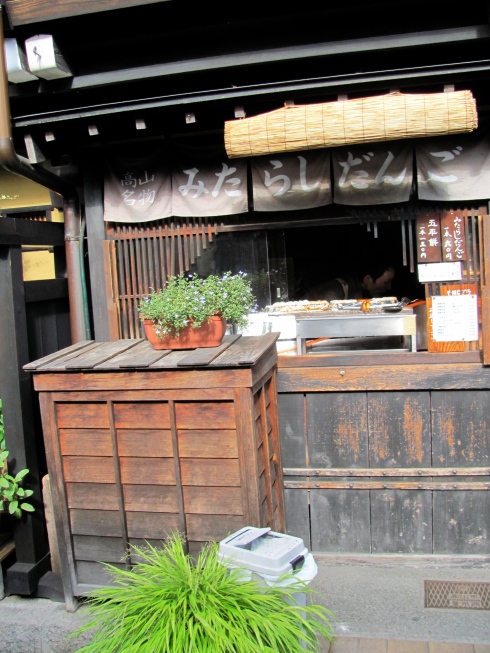
CLICK HERE to read the full post.
The Rice Cooker Chronicles: “My Rice Ball World” by Meredith Hodges-Boos
The Rice Cooker Chronicles is a series of essays by JETs and JET alumni on the theme of cooking/eating and being alone in Japan. The brain-child of JETwit founder Steven Horowitz (Aichi-ken, Kariya-shi, 1992-94) (and inspired by the book Alone in the Kitchen with an Eggplant), this series is curated by L.M. Zoller (CIR Ishikawa-ken, Anamizu, 2009-11), the editor of The Ishikawa JET Kitchen: Cooking in Japan Without a Fight. A writer and translator for The Art of Japan: Kanazawa and Discover Kanazawa, ze also writes I’ll Make It Myself!, a blog about food culture in Japan.
New submissions always welcome. Just e-mail it to Leah at jetwit [at] jetwit.com.
******
“My Rice Ball World”
by Meredith Hodges-Boos (ALT, Ehime-ken, 2003-2005). Please visit http://meredithhodgesboos.blog.com/ for more essays on her time in Japan and current literary projects.
I dragged my tired body into the entryway and found just enough energy to pry off my shoes. The door rattled on the track as I slumped into the main room of the house my husband and I shared as Assistant Language Teachers. “I’m home,” I muttered to Greg and I blinked into the bright light of the room. The glare and blare of the used Playstation we’d bought at Hard Off lit up the tatami in a rainbow of colors.

